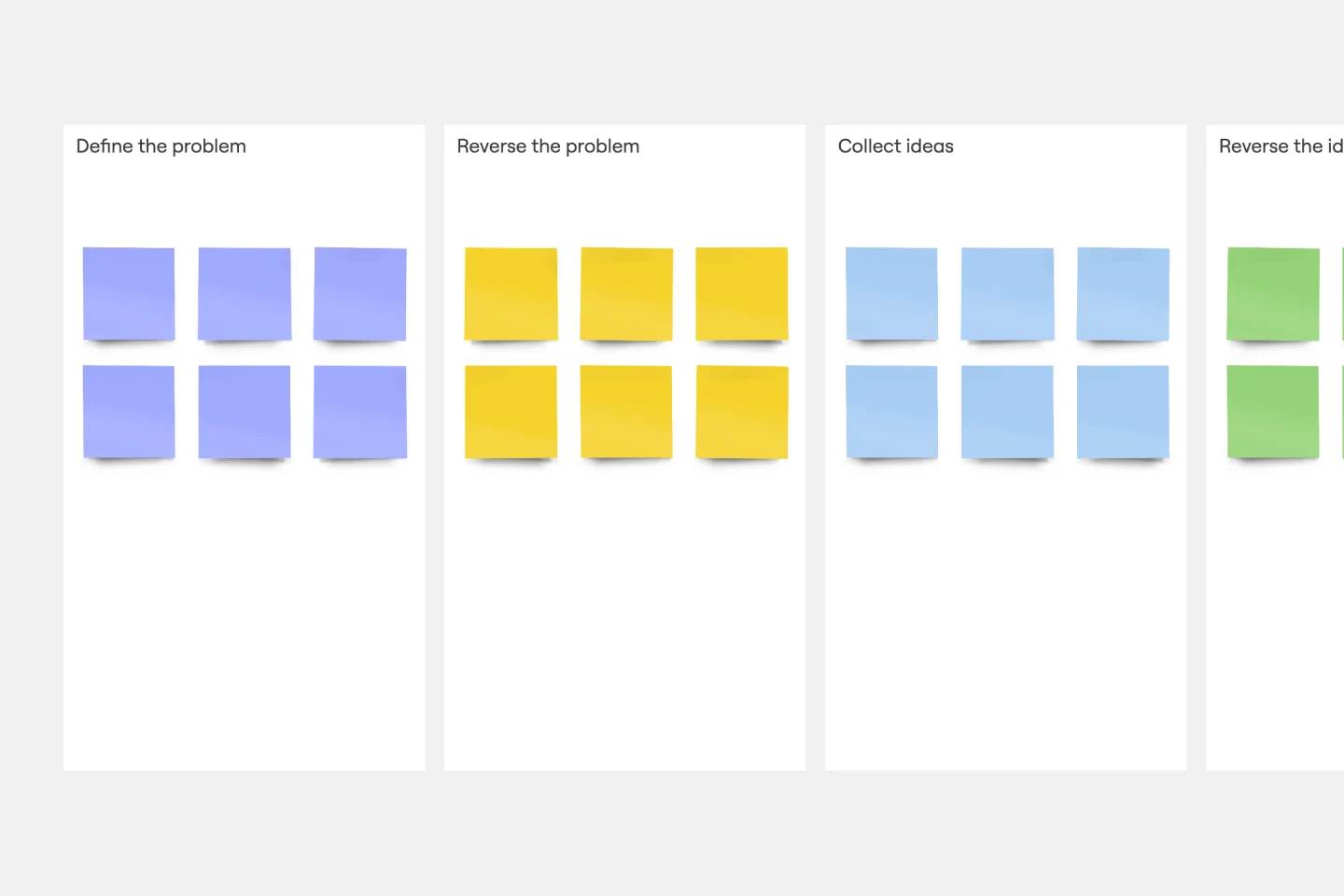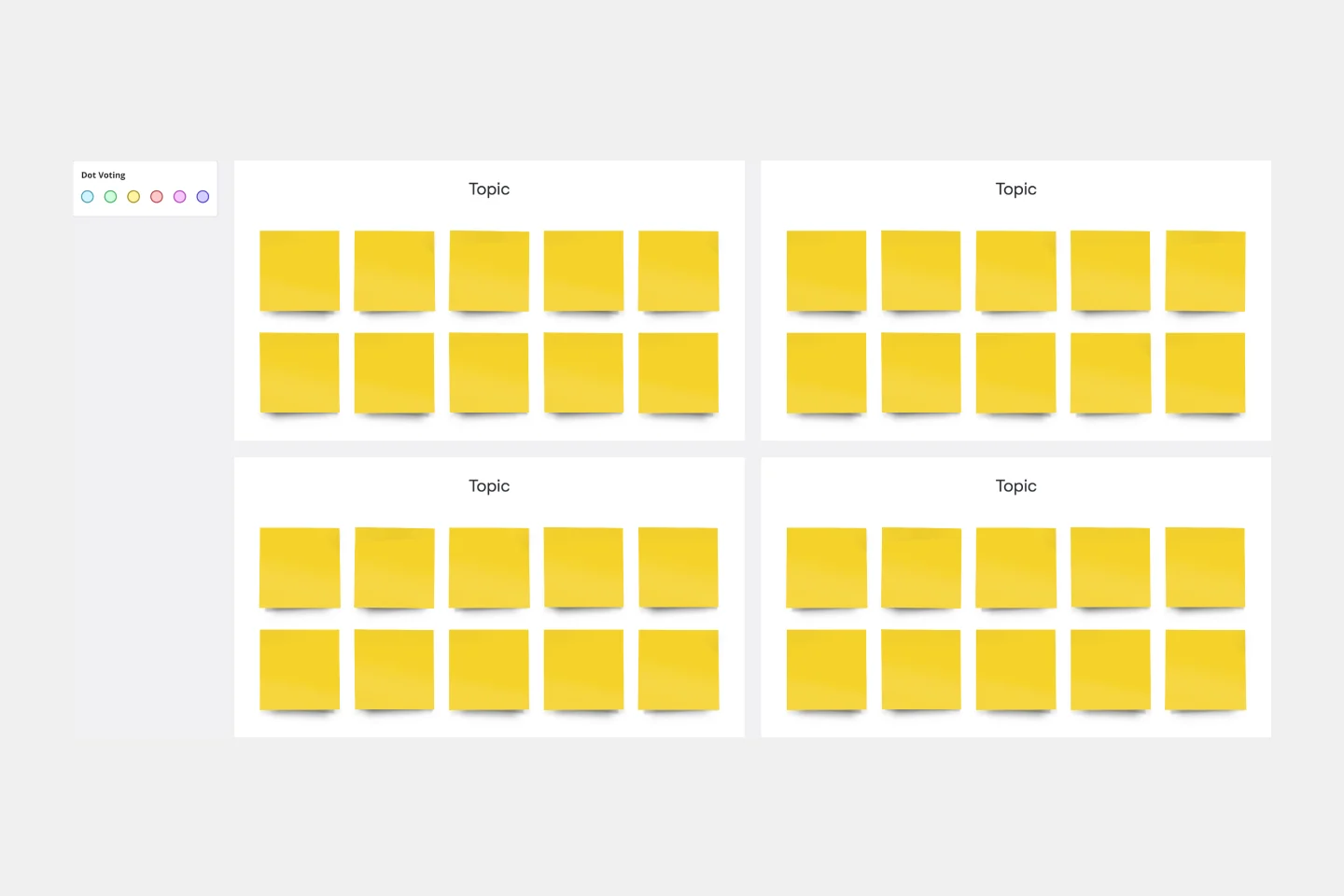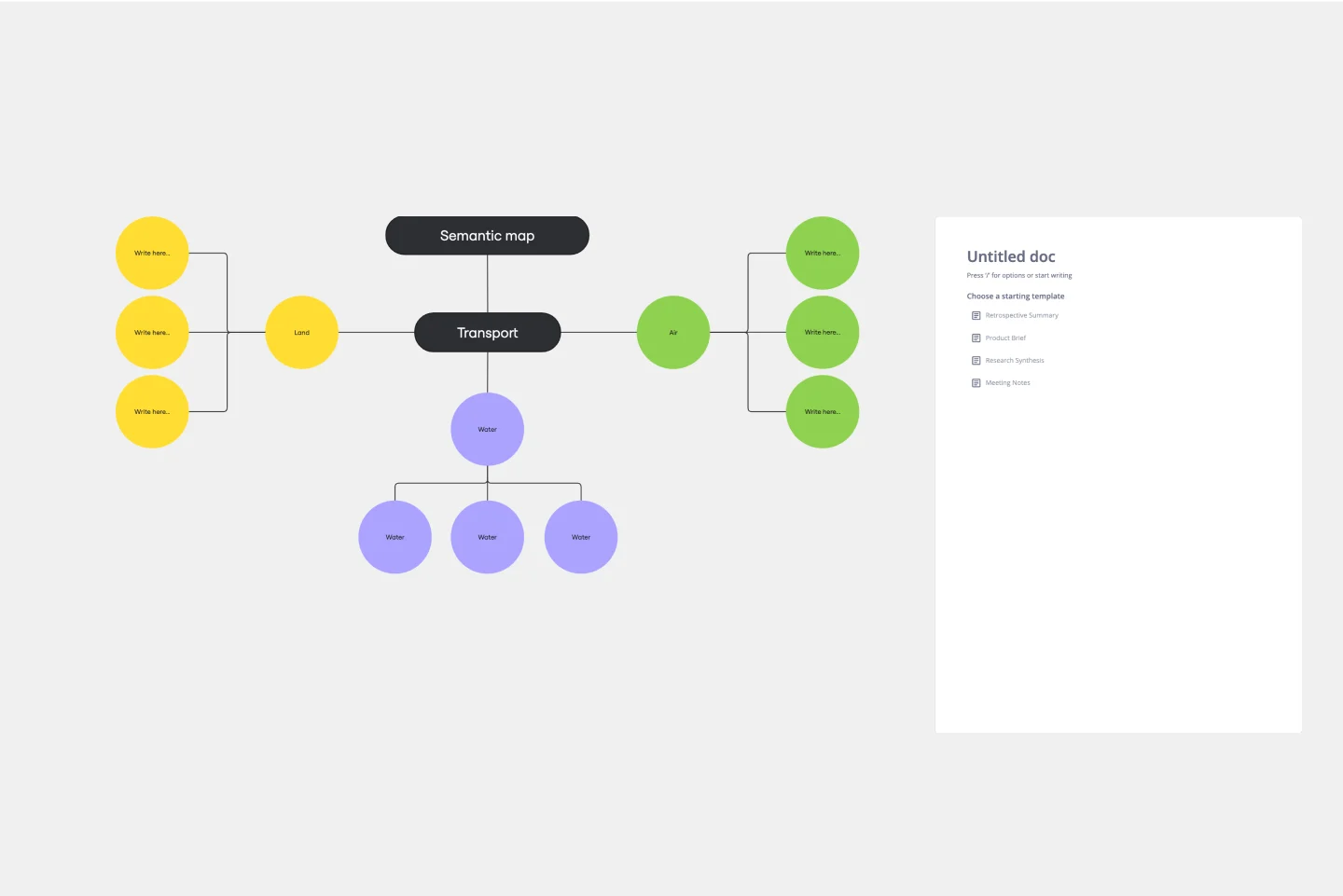About the Brainwriting Template
Not everyone works well in a brainstorming session. Some participants prefer to think ideas through before sharing them with the group. Others might struggle to think of new ideas when different people are sharing their thoughts. This is where brainwriting can help. Using the brainwriting template, you can boost group participation and stimulate new ideas.
What is brainwriting?
Brainwriting is an idea generation method. Instead of asking participants to yell out lots of ideas during your brainstorming session, the brainwriting technique involves writing them down. Here’s how it works:
The first person in the group writes their idea down on a sticky note.
Then it’s someone else’s turn.
They add their idea to another sticky note, but it can’t be the same as the idea that’s already been written.
The group repeats the process for 10–15 minutes.
The group reviews all the ideas and discusses them.
Using a brainwriting exercise, people have more time to think through their ideas before sharing them with the group. It also encourages shy and quiet participants to share their ideas in a group setting.
How to run a brainstorming session with the brainwriting template
Leading a brainwriting brainstorm is easy with Miro. Start by adding the template to a board, then take the following steps:
Step 1: Add participants’ names
Start by adding your participants’ names to each of the columns in the template. This will show them where to put their initial idea. Once you’ve added their names, you can invite them to the board to collaborate.
Step 2: Introduce the problem
At the beginning of the session, make the problem you’re trying to solve clear. Do you need to create a new product? Solve a customer issue? Whatever it is, be clear about it from the offset.
Step 3: Start writing
When everyone is ready, they can start writing. Set a timer to limit the amount of time each person has to write their suggestions. The length of time will depend on which brainwriting structure you’ve chosen. The most common structure is the 6-3-5, which involves six participants writing three ideas over 15 minutes (they have five minutes to write each idea).
Step 4: Move things along
When the timer dings, participants can move their ideas to the person on the right. Start the timer again, and ask participants to add suggestions that add to or improve upon the ideas already in the template.
Step 5: Wrap things up
Do this for as many rounds as you need to. Then, facilitate a discussion to review all the ideas. You can vote on ideas or group similar ideas together to identify trends. From here, you can continue the discussion to find the best way forward.
What are the benefits of brainwriting?
Brainwriting is a simple and effective method for generating high-quality, innovative ideas. It encourages everyone to take part, helps teams think outside the box, and streamlines the ideation process.
Let’s take a look at some of the advantages of brainwriting in more detail:
Equal participation. Because everyone works in silence, there are no dominant participants taking up floor space. Everyone has the same amount of time to think through their ideas, whether you have an outgoing or introverted team.
Encourage creativity among teams. As you move through the process, the obvious ideas are already taken. This forces participants to think outside the box and come up with fresh ideas and innovative solutions.
Rapid idea generation. Having a time limit means that teams have to think quickly throughout the process. If you’re short on time, this is a great way to get the creative juices flowing.
Helpful for remote teams. Using Miro’s brainwriting template, remote teams can conduct this process online. Forms can be filled in virtually and completed asynchronously, making it a good way for distributed teams to collaborate.
When to use brainwriting
Here are some of the common situations when brainwriting can be helpful for teams:
To generate new ideas. Brainwriting is an ideal technique for teams that want to encourage new ideas. But more than that, it forces teams to be innovative. If you’re looking for a way to get your team thinking outside the box, brainwriting could be the answer.
To create innovative solutions. The entire brainwriting process encourages original ideas from every individual. Participants have to think outside of the box to come up with a wide range of ideas that haven’t already been said. It also allows you more time to think of ideas instead of responding instantly on the spot.
To encourage everyone to participate. In a traditional brainstorming session, it’s often the loudest idea that wins. With brainwriting, everyone gets a chance to have their voices heard.
Brainwriting FAQs
How do I conduct a remote brainwriting session?
You’ll start by rounding up your group participants and preparing your notes for the session. When everything is ready to go, you’ll get participants to offer their ideas and move the notes along so that everyone in the group can have their input. At the end of the session, you’ll review the notes and figure out the best way to move forward. If you want to make the process easier, we’d suggest using the Brainwriting Template. It’s intuitive, easy to navigate, and free!
What is the difference between brainstorming and brainwriting?
A typical brainstorming session requires everyone in the group to participate vocally, which is different from the brainwriting process. Instead of getting people to discuss ideas out loud, brainwriting involves writing ideas down and sharing them with the group.
What is an alternate name for brainwriting?
There’s more than one name for brainwriting. It’s sometimes known as the 6-3-5 brainwriting method. This outlines the structure for the process (six people, three ideas, 15 minutes). It can also be 4-3-2, depending on how many participants you have and whether you’re in a time crunch.

Miro
Your virtual workspace for innovation
Miro is an innovation workspace designed for teams of every size, everywhere, to dream, design, and build the future together. Our mission? To empower these teams to create the next big thing, powered by AI at every step of the way. Over 90 million users around the world rely on Miro to untangle complex ideas, put customer needs first, and deliver products and services faster. All supported by best-in-class security, compliance, and scalability.
Categories
Similar templates
Reverse Brainstorming Template

Reverse Brainstorming Template
Reverse brainstorming is a technique that prompts a group to think of problems, rather than solutions. Because we naturally think of problems, it’s a great way to get a group to anticipate problems that may occur during a project. To engage in reverse brainstorming, start by identifying the problem, and then think of things that might exacerbate it. Ask your team to generate ideas around ways in which the problem could get worse. Reverse the problems into solutions again, and then evaluate your ideas.
Research Topic Brainstorm Template

Research Topic Brainstorm Template
Coming up with a topic for a research project can be a daunting task. Use the Research Topic Brainstorm template to take a general idea and transform it into something concrete. With the Research Topic Brainstorm template, you can compile a list of general ideas that interest you and then break them into component parts. You can then turn those parts into questions that might be the focus for a research project.
Random Words Template

Random Words Template
Random word brainstorming is a simple, creative technique using random words to generate new ideas and creative solutions to your problems. Using random word prompts allows you to step beyond traditional boundaries and address challenges from a different direction. Random word brainstorming allows your team to unlock their creativity to solve business problems, create new inventions, improve existing ideas, or just think about problems in a new way.
Semantic Map Template

Semantic Map Template
The Semantic Map Template is a helpful tool that helps teams efficiently process and structure complex information. Its intuitive design promotes shared understanding, allowing multiple users to contribute and refine ideas simultaneously. This collaborative approach streamlines brainstorming sessions and creates a synergistic environment where collective intelligence thrives. By visually mapping out concepts and their interconnections, the template ensures that every team member is on the same page, which improves group dynamics and leads to more cohesive and comprehensive outcomes. The Semantic Map Template is a valuable tool for team-based project management and learning, thanks to its ability to foster collaboration and enhance productivity.
SCAMPER Model

SCAMPER Model
Is your team in a rut? Have you had a lingering problem that can’t seem to be solved? First introduced in 1972, SCAMPER. is a brainstorming method developed by Bob Eberle, an author of creativity books for young people. This clever, easy-to-use method helps teams overcome creative roadblocks. SCAMPER walks you through seven questions that are meant to encourage your team to approach a problem through seven unique filters. By asking your team to think through a problem using this framework, you’ll unlock fresh, innovative ways to understand the problem you’re trying to solve.
Crazy Eights Template

Crazy Eights Template
Sometimes you just need to get the team’s creative juices flowing for a brainstorm—and get them thinking of as many ideas as they can, as fast as they can. Crazy Eights will do it in a hurry. Favoring quantity over quality, this sketch brainstorming exercise challenges them to come up with eight ideas in eight minutes, which leaves no time to second guess ideas. It’s perfect for early stages of development, and it’s a team favorite for being fast paced and fun.
Mandala Chart Template

Mandala Chart Template
The Mandala Chart Template helps you visualize the relationships between a central theme and its sub-themes. One of the key benefits is how it fosters a holistic understanding of any topic. This perspective ensures every detail is noticed, making it an invaluable asset for those aiming for comprehensive insight and thorough planning or a better understanding of their goals.
Six Thinking Hats Template

Six Thinking Hats Template
The Six Thinking Hats by Dr. Edward de Bono was created as an alternative to argument, it is designed to help teams explore and develop ideas collaboratively. Use this template to boost creative thinking and get different perspectives so you and your team can make better-informed decisions.
Reverse Brainstorming Template

Reverse Brainstorming Template
Reverse brainstorming is a technique that prompts a group to think of problems, rather than solutions. Because we naturally think of problems, it’s a great way to get a group to anticipate problems that may occur during a project. To engage in reverse brainstorming, start by identifying the problem, and then think of things that might exacerbate it. Ask your team to generate ideas around ways in which the problem could get worse. Reverse the problems into solutions again, and then evaluate your ideas.
Research Topic Brainstorm Template

Research Topic Brainstorm Template
Coming up with a topic for a research project can be a daunting task. Use the Research Topic Brainstorm template to take a general idea and transform it into something concrete. With the Research Topic Brainstorm template, you can compile a list of general ideas that interest you and then break them into component parts. You can then turn those parts into questions that might be the focus for a research project.
Random Words Template

Random Words Template
Random word brainstorming is a simple, creative technique using random words to generate new ideas and creative solutions to your problems. Using random word prompts allows you to step beyond traditional boundaries and address challenges from a different direction. Random word brainstorming allows your team to unlock their creativity to solve business problems, create new inventions, improve existing ideas, or just think about problems in a new way.
Semantic Map Template

Semantic Map Template
The Semantic Map Template is a helpful tool that helps teams efficiently process and structure complex information. Its intuitive design promotes shared understanding, allowing multiple users to contribute and refine ideas simultaneously. This collaborative approach streamlines brainstorming sessions and creates a synergistic environment where collective intelligence thrives. By visually mapping out concepts and their interconnections, the template ensures that every team member is on the same page, which improves group dynamics and leads to more cohesive and comprehensive outcomes. The Semantic Map Template is a valuable tool for team-based project management and learning, thanks to its ability to foster collaboration and enhance productivity.
SCAMPER Model

SCAMPER Model
Is your team in a rut? Have you had a lingering problem that can’t seem to be solved? First introduced in 1972, SCAMPER. is a brainstorming method developed by Bob Eberle, an author of creativity books for young people. This clever, easy-to-use method helps teams overcome creative roadblocks. SCAMPER walks you through seven questions that are meant to encourage your team to approach a problem through seven unique filters. By asking your team to think through a problem using this framework, you’ll unlock fresh, innovative ways to understand the problem you’re trying to solve.
Crazy Eights Template

Crazy Eights Template
Sometimes you just need to get the team’s creative juices flowing for a brainstorm—and get them thinking of as many ideas as they can, as fast as they can. Crazy Eights will do it in a hurry. Favoring quantity over quality, this sketch brainstorming exercise challenges them to come up with eight ideas in eight minutes, which leaves no time to second guess ideas. It’s perfect for early stages of development, and it’s a team favorite for being fast paced and fun.
Mandala Chart Template

Mandala Chart Template
The Mandala Chart Template helps you visualize the relationships between a central theme and its sub-themes. One of the key benefits is how it fosters a holistic understanding of any topic. This perspective ensures every detail is noticed, making it an invaluable asset for those aiming for comprehensive insight and thorough planning or a better understanding of their goals.
Six Thinking Hats Template

Six Thinking Hats Template
The Six Thinking Hats by Dr. Edward de Bono was created as an alternative to argument, it is designed to help teams explore and develop ideas collaboratively. Use this template to boost creative thinking and get different perspectives so you and your team can make better-informed decisions.